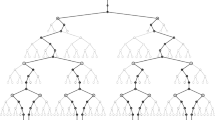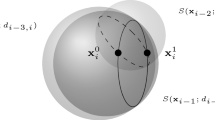Abstract
The fundamental inverse problem in distance geometry is the one of finding positions from inter-point distances. The Discretizable Molecular Distance Geometry Problem (DMDGP) is a subclass of the Distance Geometry Problem (DGP) whose search space can be discretized and represented by a binary tree, which can be explored by a Branch-and-Prune (BP) algorithm. It turns out that this combinatorial search space possesses many interesting symmetry properties that were studied in the last decade. In this paper, we present a new algorithm for this subclass of the DGP, which exploits DMDGP symmetries more effectively than its predecessors. Computational results show that the speedup, with respect to the classic BP algorithm, is considerable for sparse DMDGP instances related to protein conformation.



Similar content being viewed by others
Notes
It is clear that the sequence \(e_1,e_2,\dots ,e_m\) induces a total order on the pruning edges such that \(\{ i_k, j_k \} = e_{k} < e_{\ell } = \{ i_{\ell }, j_{\ell } \}\).
We ran mdjeep (version 0.3) with default parameters except for the tolerance \(\varepsilon =10^{-4}\) (the default is \(\varepsilon =10^{-3}\)) concerning pruning distance constraints.
References
Alencar, J., Lavor, C., Liberti, L.: Realizing Euclidean distance matrices by sphere intersection. Discret. Appl. Math. 256, 5–10 (2019)
Baez-Sanchez, A., Lavor, C.: On the estimation of unknown distances for a class of Euclidean distance matrix completion problems with interval data. Linear Algebra Appl. 592, 287–305 (2020)
Berman, H.M., Westbrook, J., Feng, Z., Gilliland, G., Bhat, T.N., Weissig, H., Shindyalov, I.N., Bourne, P.E.: The protein data bank. Nucl. Acids Res. 28, 235–242 (2000)
Billinge, S., Duxbury, P., Gonçalves, D., Lavor, C., Mucherino, A.: Assigned and unassigned distance geometry: applications to biological molecules and nanostructures. 4OR 14, 337–376 (2016)
Billinge, S., Duxbury, P., Gonçalves, D., Lavor, C., Mucherino, A.: Recent results on assigned and unassigned distance geometry with applications to protein molecules and nanostructures. Ann. Oper. Res. 271, 161–203 (2018)
Camargo, V.S., Castelani, E.V., Fernandes, L.A.F., Fidalgo, F.: Geometric algebra to describe the exact discretizable molecular distance geometry problem for an arbitrary dimension. Adv. Appl. Clifford Algebras 29(75), (2019)
Cassioli, A., Günlük, O., Lavor, C., Liberti, L.: Discretization vertex orders in distance geometry. Discret. Appl. Math. 197, 27–41 (2015)
Costa, T., Bouwmeester, H., Lodwick, W., Lavor, C.: Calculating the possible conformations arising from uncertainty in the molecular distance geometry problem using constraint interval analysis. Inf. Sci. 415, 41–52 (2017)
Crippen, G., Havel, T.: Distance Geometry and Molecular Conformation. Wiley, New York (1988)
Dokmanic, I., Parhizkar, R., Ranieri, J., Vetterli, M.: Euclidean distance matrices: essential theory, algorithms, and applications. IEEE Signal Proc. Magaz. 32(6), 12–30 (2015)
Dong, Q., Wu, Z.: A geometric build-up algorithm for solving the molecular distance geometry problem with sparse distance data. J. Global Optim. 26(3), 321–333 (2003)
Fidalgo, F., Gonçalves, D., Lavor, C., Liberti, L., Mucherino, A.: A symmetry-based splitting strategy for discretizable distance geometry problems. J. Global Optim. 71, 717–733 (2018)
Gramacho, W., Mucherino, A., Lavor, C., Maculan, N.: A parallel BP algorithm for the discretizable distance geometry problem. In: Proceedings of the Workshop on Parallel Computing and Optimization, pp. 1756–1762. IEEE, Piscataway (2012)
Krislock, N., Wolkowicz, H.: Explicit sensor network localization using semidefinite representations and facial reductions. SIAM J. Optim. 20, 2679–2708 (2010)
Lavor, C., Liberti, L., Donald, B., Worley, B., Bardiaux, B., Malliavin, T., Nilges, M.: Minimal NMR distance information for rigidity of protein graphs. Discret. Appl. Math. 256, 91–104 (2019)
Lavor, C., Liberti, L., Maculan, N., Mucherino, A.: The discretizable molecular distance geometry problem. Comput. Optim. Appl. 52, 115–146 (2012)
Lavor, C., Liberti, L., Maculan, N., Mucherino, A.: Recent advances on the discretizable molecular distance geometry problem. Eur. J. Oper. Res. 219, 698–706 (2012)
Lavor, C., Liberti, L., Mucherino, A.: The interval BP algorithm for the discretizable molecular distance geometry problem with interval data. J. Global Optim. 56, 855–871 (2013)
Lavor, C., Oliveira, A., Rocha, W., Souza, M.: On the optimality of finding DMDGP symmetries. Comput. Appl. Math. 40, 98–107 (2021)
Lavor, C., Souza, M., Carvalho, L., Gonçalves, D., Mucherino, A.: Improving the sampling process in the interval branch-and-prune algorithm for the discretizable molecular distance geometry. Appl. Math. Comput. 389, 125586–125597 (2021)
Lavor, C., Souza, M., Carvalho, L.M., Liberti, L.: On the polynomiality of finding \({}^K\)DMDGP re-orders. Discret. Appl. Math. 267, 190–194 (2019)
Liberti, L.: Distance geometry and data science. TOP 28, 271–339 (2020)
Liberti, L., Lavor, C.: Euclidean Distance Geometry: An Introduction. Springer, New York (2017)
Liberti, L., Lavor, C., Alencar, J., Abud, G.: Counting the number of solutions of \({}^k\)DMDGP instances. In: Nielsen, F., Barbaresco, F. (eds.) Geometric Science of Information. Lecture Notes in Computer Science, vol. 8085, pp. 224–230. Springer, Berlin (2013)
Liberti, L., Lavor, C., Maculan, N.: A branch-and-prune algorithm for the molecular distance geometry problem. Int. Trans. Oper. Res. 15, 1–17 (2008)
Liberti, L., Lavor, C., Maculan, N., Mucherino, A.: Euclidean distance geometry and applications. SIAM Rev. 56, 3–69 (2014)
Liberti, L., Lavor, C., Mucherino, A.: The Discretizable Molecular Distance Geometry Problem Seems Easier on Proteins. In: Mucherino, A., Lavor, C., Liberti, L., Maculan, N. (eds.) Distance Geometry, pp. 47–60. Springer, New York (2013)
Liberti, L., Masson, B., Lee, J., Lavor, C., Mucherino, A.: On the number of solutions of the discretizable molecular distance geometry problem. In: Combinatorial Optimization. Constraints and Applications (COCOA11), LNCS, vol. 6831, pp. 322–342. Springer, New York (2011)
Liberti, L., Masson, B., Lee, J., Lavor, C., Mucherino, A.: On the number of realizations of certain Henneberg graphs arising in protein conformation. Discret. Appl. Math. 165, 213–232 (2014)
Maioli, D., Lavor, C., Gonçalves, D.S.: A note on computing the intersection of spheres in \(\mathbb{R}^n\). ANZIAM J. 59(2), 271–279 (2017)
Malliavin, T., Mucherino, A., Lavor, C., Liberti, L.: Systematic exploration of protein conformational space using a distance geometry approach. J. Chem. Inf. Model. 59, 4486–4503 (2019)
Moré, J.J., Wu, Z.: Distance geometry optimization for protein structures. J. Global Optim. 15, 219–234 (1999)
Mucherino, A., Lavor, C., Liberti, L.: Exploiting symmetry properties of the discretizable molecular distance geometry problem. J. Bioinform. Comput. Biol. 10(3), 1242009(1–15) (2012)
Mucherino, A., Lavor, C., Liberti, L., Maculan, N. (eds.): Distance Geometry: Theory, Methods, and Applications. Springer, Berlin (2013)
Neto, L.S., Lavor, C., Lodwick, W.: A note on the Cayley-Menger determinant and the molecular distance geometry problem. Inf. Sci. 559, 1–7 (2021)
Newman, M.E., Ziff, R.M.: Fast Monte Carlo algorithm for site or bond percolation. Phys. Rev. E 64(1), 016706 (2001)
Nucci, P., Nogueira, L., Lavor, C.: Solving the discretizable molecular distance geometry problem by multiple realization trees. In: Mucherino et al. [34], pp. 161–176
Saxe, J.B.: Embeddability of weighted graphs in \(k\)-space is strongly NP-hard. In: Proceedings of \(17^{th}\) Allerton Conference in Communications, Control and Computing, pp. 480–489. Monticello, IL (1979)
Wütrich, K.: Protein structure determination in solution by nuclear magnetic resonance spectroscopy. Science 243, 45–50 (1989)
Acknowledgements
We would like to thank Prof. Luiz M. Carvalho for valuable discussions. This work was partly supported by: (a) the Brazilian research agencies CNPq, CAPES, and FAPESP; (b) the French research agency ANR under grant ANR-19-CE45-0019 “multiBioStruct”; (c) the European Union’s Horizon 2020 research and innovation programme under the Marie Sklodowska-Curie Grant Agreement No. 764759 ETN “MINOA”. Part of this work was done during the visit of DG to LL at École Polytechnique, supported by CAPES/Print Process 88887.465828/2019-00.
Author information
Authors and Affiliations
Corresponding author
Ethics declarations
Conflict of interest
The authors declare that they have no conflict of interest.
Additional information
Publisher's Note
Springer Nature remains neutral with regard to jurisdictional claims in published maps and institutional affiliations.
This is an extended version of an abstract published at CTW2020.
Appendix: Proof of Lemma 2
Appendix: Proof of Lemma 2
Proof
Since \(x(s')\) from Eq. (4) involves only partial reflections, in view of Property 3 in Remark 2, \(x(s') \in \hat{X}\), i.e \(\Vert x_u(s') - x_w(s') \Vert = d_{uw}, \forall \{u,w\} \in E_D\).
It remains to show that \(x(s')\) does not violate distance constraints associated to pruning edges in \(P^{ij}\). Since the reflections are applied to positions \(x_{\ell }\) such that \(\ell \ge i+K+1\), pruning edges \(\{u,w\} \in P^{ij}\) with \(u<w\le i+K\) are not affected. Thus, assume that \(i+K+1 \le w \le n\). If \(u \le i\), then for \(\ell = i+K+1,\dots ,w\) there exists \(\{u,w\}\) such that \(u+K+1 \le \ell \le w\), which implies that \(v_{i+K+1},\dots ,v_{w} \not \in S^{ij}\), meaning that the first symmetry vertex \(v_{\ell }\) in \(S^{ij}\) is such that \(\ell \ge w+1\). Thus, according to (2) and (4), partial reflections are not applied to \(x_{i+K+1},\dots ,x_{w}\), i.e \(x_{\ell }(s') = x_{\ell }(s)\), for \(\ell =i+K+1,\dots ,w\) and \(\Vert x_u(s') - x_w(s') \Vert = d_{uw}\) holds. Otherwise, for \(u \ge i+1\), we have that \(v_{u+K+1},\dots ,v_w \not \in S^{ij}\), and from (4) and (2), positions \(x_{\ell },\dots ,x_{u+K+1},\dots ,x_w\) are updated by reflections \(R_{x}^{\ell }(x_{\ell }), \dots , R_{x}^{\ell }(x_{u+K+1}), \dots , R_{x}^{\ell }(x_w)\), for \(i+K+1 \le \ell \le u+K\) such that \(v_{\ell } \in S^{ij}\). Since either \(u \le \ell - 1\), i.e \(x_u\) is in the hyperplane associated to \(v_{\ell }\), or \(u \ge \ell \), i.e. \(x_u\) comes after this hyperplane, in view of Remark 2, Property 2, these reflections are such that \(\Vert x_u(s') - x_v(s') \Vert = d_{uw}\). \(\square \)
Rights and permissions
About this article
Cite this article
Gonçalves, D.S., Lavor, C., Liberti, L. et al. A New Algorithm for the \(^K\)DMDGP Subclass of Distance Geometry Problems with Exact Distances. Algorithmica 83, 2400–2426 (2021). https://doi.org/10.1007/s00453-021-00835-6
Received:
Accepted:
Published:
Issue Date:
DOI: https://doi.org/10.1007/s00453-021-00835-6




